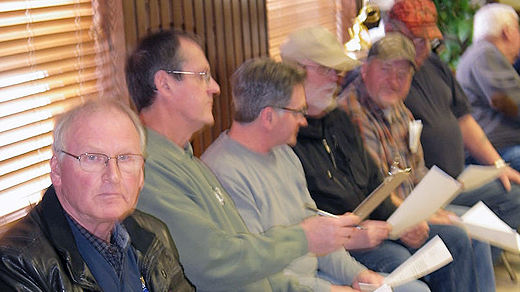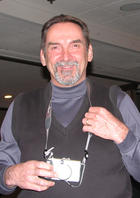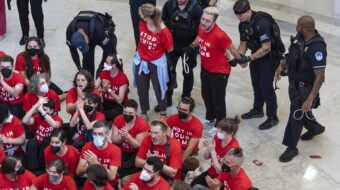
DULUTH, Minn. (PAI) – A half mile from their union hall, over 220 retired members of Teamsters Local 346 gathered at Holy Family Catholic Church in Duluth’s West End in late January to fight for their pensions.
But this isn’t just a Teamsters fight. They’re one of the unions under the knife now, but 200 multi-employer pension funds covering 1.5 million American workers could be in jeopardy for a number of reasons.
One reason is the Multi-Employer Pension Reform Act (MPRA) of 2014 signed into law as part of the omnibus spending bill. MPRA gave trustees the green light to slash pensions.
A couple of decades ago the Teamsters Central States Pension Fund (CSPF) was one of the best union pension funds in the nation. Teamsters were retiring at age 48 after 30 years of service to a signatory employer and taking home pensions in the $3,000-a-month range.
CSPF trustees say those days are over: The Chicago-based fund has been in critical status for some time. Their solution is an application to the Treasury Department, allowed by the MPRA, to cut pension payouts for current retirees in order to save the fund’s future.
Fighting back, Teamster retiree chapters have created Committees to Protect Pensions. They say it is CSPF managers and trustees, the Wall Street fund managers they used, and the federal government that fell asleep at the wheel and caused most of the pension fund’s financial problems.
In October, CSPF trustees notified some 273,000 retirees in 38 states that their pensions would be cut by as much as 50 to 70 percent. But their idea of a “rescue plan” will ultimately affect 400,000 Teamsters and decimate the pensions of many young members working today.
Trustees filed an application with the Treasury to begin cutting benefits for current and future Teamster retirees on July 1, 2016.
Teamsters decided to respond with fight-back meetings across the nation like the one at Holy Family. The Duluth meeting was a chance to educate retirees about the pension cuts because the CSPF has given little information.
One reason for that: The CSPF’s chief supports the application, while Teamsters President Jim Hoffa doesn’t. And Rep. Rick Nolan, DFL-Minn., joined the Teamsters in Duluth to say he was in their fight with them. Hoffa strongly supports legislation, introduced last year by Sen. Bernie Sanders, Ind-Vt., Nolan and Rep. Marcy Kaptur, D-Ohio, to undo the MPRA.
So do several other unions, notably the Machinists. They argued hard against the MPRA before Congress approved it.
Retired Teamster Local 346 Secretary-Treasurer Sherm Liimatainen is part of the Duluth area’s leadership group fighting the pension cuts. He has traveled to Ohio, Illinois, and Wisconsin to help the fight-back effort.
“We have been betrayed by our fiduciary agents,” Liimatainen told the gathering about the CSPF trustees. “They failed to protect us from Wall Street predators.” He said Wall Street firms charged exorbitant fees and then used Teamster pension funds to shore up weak funds that they had created for their rich VIP investors.
Now Central States trustees are telling retirees that the trustees’ rescue plan is the one and only solution. They want retirees to vote “yes” for it in a Participants’ Ratification Process. But opponents of the plan call the whole idea bogus because no matter how retirees vote, the Treasury Department can go ahead and approve the pension cuts.
Liimatainen said the voting process is actually disenfranchisement, because it means nothing. Plus, not voting is considered a “yes” vote and many retirees may not be healthy enough, or technologically savvy enough, to understand what is happening to their pensions.
So the fight-back committees are asking retirees to sign petitions against the plan and to vote “no” so they could have legal status to continue to challenge the cuts. The committees also created a Teamsters Pension Protection Hotline, 1-888-979-9806, to allow retirees and members to urge lawmakers to pressure Treasury to reject the CSPF application.
Liimatainen said the little information the CSPF trustees and managers are giving out “has no answers, or slanted answers, has no clear data, and is full of assumptions.” He said trustees are saying they are only bringing in one dollar for every $3.46 that is going out, resulting in a $2 billion annual deficit.
“That’s a hoax,” said Liimatainen. The fund has $17.775 billion in reserves that are making $1.333 billion in investment income at 7.5 percent according to the trustees, but they aren’t including those numbers in their projections. “That makes $3 in for every $3.46 out, which is still a serious shortfall at 46 cents,” he admitted.
The workers’ pension committees also say the trustees allowed many employers to not make full pension contributions by creating a “distressed employer” provision and they didn’t offset those losses.
The committees are calling for CSPF trustees to resign and for a federal investigation into how so many levels of government oversight of the Teamsters and their pension funds could have allowed things to get so bad.
The federal government came down on the Teamsters with a 1989 consent decree that had the government looking over everything the union did after mob-related connections and illegal activity were uncovered. The consent decree was lifted just a year ago, ending 25 years of government supervision of the Teamsters.
The retiree committees say the federal Labor and Treasury Departments, the FBI and the IRS, and the Pension Benefit Guaranty Corporation – which provides reduced pensions for retirees whose pension funds go broke or shut down due to corporate bankruptcies – all need to be investigated for their professional incompetence in “not realizing that the foxes (Wall Street firms) could not be trusted to protect the chickens (members of the CSPF).”
A bit of history
The PBGC was created in 1974 as part of the Employee Retirement Income Security Act (ERISA), a federal law that sets minimum standards for most pension and health plans in private industry to provide protection for individuals in the plans. PBGC is supposed to protect pensions but is almost insolvent itself.
The agency’s looming financial crunch gave CSPF trustees another green light to say PBGC will be insolvent at the same time as their pension fund – in what the retirees call another excuse for the need for their “rescue plan.”
But recent U.S. history points to bailouts of savings and loans, Fannie Mae, Freddie Mac, Wall Street (“too big to fail”) and the auto industry. The federal government has allowed PBGC to operate undercapitalized for 40 years, jeopardizing the retirement security of the taxpaying American workers it was created to protect, the retirees point out.
The retiree committees want to know why tax dollars can’t be used to bail out the PBGC and hardworking retirees who deserve a fair shake.
Major problems for the 200 multi-employer pension funds covering 1.5 million workers took a huge hit when Congress passed the Multi-Employer Pension Reform Act as part of the omnibus spending bill. MPRA gave trustees the green light to slash pensions.
“If anyone tells you they didn’t know what was in the 2014 omnibus bill they’re not telling you the truth,” Nolan told the Holy Family meeting, speaking about his colleagues. “It was well known and debated on the House floor.” He said it was bad legislation and he voted against it.
Nolan, Kaptur and 16 other House Democrats are urging Treasury to reject the MPRA and the CSPF rescue plan. They are pushing the Keep Our Pension Promises Act (HR2844) to repeal MPRA. That’s the measure (S1631) Sanders has also introduced.
While MPRA opened the door to pension cuts, HR2844 would shore up the PBGC by closing two tax loopholes used almost entirely by wealthy estates to reduce their tax burdens.
Another bill, the Pension Accountability Act (S2147, HR4029) would restore fairness and credibility in the voting process for pension cuts that may be proposed by plans.
Nolan, Liimatainen, and current Teamster Local 346 Secretary-Treasurer Rod Alstead told Teamster retirees at the Duluth meeting that their fight isn’t over.
“We can fix this thing,” Nolan said. “By God, if we found a way to fix Wall Street when they needed it, we can fix the pensions of those who paid into them.”
Alstead told those gathered at Holy Family their voices would be heard by Kenneth Feinberg, whom the Treasury appointed as a special master for the Central States pension case, and all other parties involved in the CSPF “rescue plan.” Alstead promised the group that everything they had heard would be submitted for the record. He said he was proud of the Minnesota congressional delegation that represents them for their support.
“Local 346 and the Teamsters can’t control what happened at the Central States Pension Fund because we don’t sit on that board,” Alstead told the gathering. “But we do sit on the Minnesota Highway Heavy pension fund with Teamster Locals 120 and 160, and I can tell you that pension is 93 percent funded. We sit as trustees and we’ve done well. We will continue to fight this race to the bottom or in 10 to 20 years everything will be gone.”
Retired IBT Local 346 Secretary-Treasurer Pat Radzak said he was sick about what was happening to their retirees. “We told them forever to let wage increases go and put everything they could into their pensions so they’d have secure retirements,” Radzak said. “And look what they got for it. It’s just not right.”
Nolan said Kaptur and he have met with Feinberg. He said he can’t predict what Feinberg will do but he’s cautiously optimistic for a good decision for retirees. Nolan called Feinberg a “good man with good judgment who is donating his time in the effort to come to terms with the pension fund.” Feinberg did reparation work on the World Trade Center attack.
“We have 10 or 15 years to fix this thing so let’s step up now and finally do it,” Nolan said. “They don’t even know if [the CSPF plan] will work, so why the hell do it? Let’s take the time and do it right!”
“Pensions are paychecks, not handouts,” Kaptur has said. “If the United States of America could bail out Wall Street, whose risky behavior robbed pension funds of workers’ hard-earned benefits they’ve earned over a lifetime of hard work across our nation, surely we can find a way to restore retired workers’ earned pensions. There are other solutions working their way through Congress that don’t pick the pockets of workers and retirees to pay for financial losses for which they bear no responsibility.”
The author is editor of the Duluth Labor World.
Photo: Greg Lesczynski’s expression was typical of many Teamster Local 346 retirees at the Jan. 21 meeting about their proposed pension cuts. Next to him is Rick Braun who is signing a petition against the cuts. Braun said he was informed his pension will be reduced by 60.6 percent. He said he found the meeting “inspiring” in that maybe the cuts could be stopped or lessened. These retirees were co-workers for decades in food distribution warehouses for Twin Ports Grocery, Gateway, and Fleming foods. Duluth Labor World photo












Comments